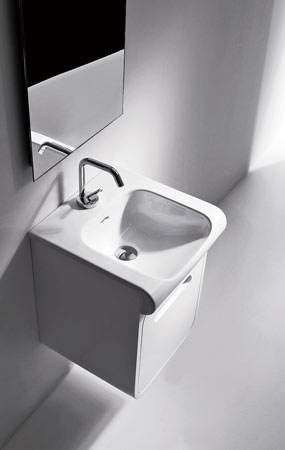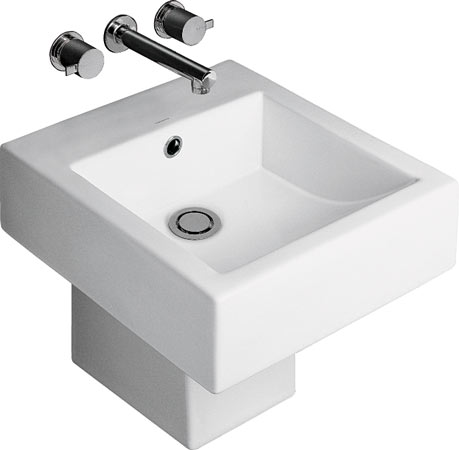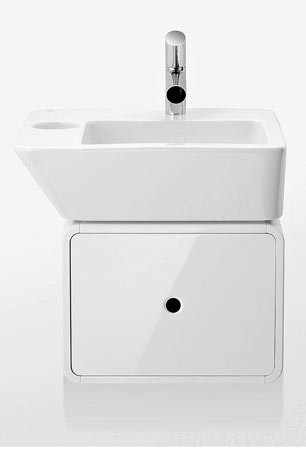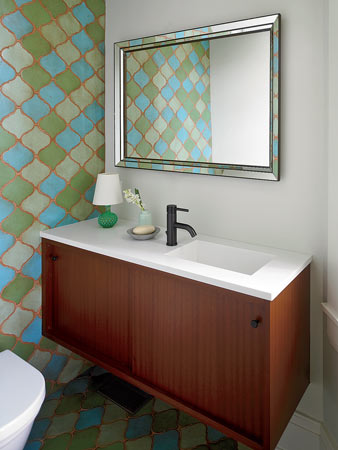
Hastings’s Ink sink and vanity pack maximum curves into minimal space.
Q: I have a tiny powder room and am looking for a scaled-down sink/vanity combination with storage. I’m having trouble finding stylish options.
A: You’re not alone in your quest for a small sink that’s also beautiful. We hunted around and found a lot of great choices (some with storage), including Hastings’s Ink, which is meant to visually mimic an infinity pool (sink, 15¾ by 15¾ inches, $585; vanity, $1,500). Hastings’s Sonia Atic vanity has a large drawer with two removable trays (sink, 19¾ by 17¾ inches, $500; vanity, same size, $1,680). Both are at Hastings, at the Merchandise Mart (312-527-0565).

Caroma’s Liano has a sloping, extra-deep bowl.
If you can forgo storage, Caroma’s Liano has a modern, minimalist look and a generously deep bowl (sink, 16½ by 18½ inches, $338; decorative drain cover/trap, $148). It’s available at Aquae Sulis (2211 N. Elston Ave., 773-772-7272).

The Laufen Alessi dOT sink pairs with a nifty cabinet.
The understated Laufen Alessi dOT unit (sink, 23¾ by 19¾ by 71⁄8 inches, $1,850; cabinet, $2,100) is available at Waterware (1829 S. State St., 312-225-4549). Another place to look is Community Home Supply (3924 N. Lincoln Ave., 773-281-7010), where design consultants will help you put together a lovely and efficient space using pieces from their small-bathroom showroom.

Architect Claudia Skylar designed this vanity for a tiny powder room with an angled wall.
Made of quartersawn makore wood, it’s finished with an integrated Corian sink and countertop.
You might also consider going custom, as architect Claudia Skylar (mastroskylararchitects.com) recently did for a client. The powder room, a small space with one angled wall, was too narrow for a standard fixture, so Skylar designed her own. She came up with a cabinet of quartersawn makore wood with an integrated Corian sink, then collaborated with Sprovieri’s Custom Countertops (sprovieris.com) and Wettengel Woodworking (wettengelwoodworking.com) on its fabrication.
And speaking of tight spaces, Skylar is also a fan of wall-mounted toilets because the tank goes behind the wall, saving valuable square footage. The one in the powder room shown above is from Duravit.
Photograph: (Claudia Skylar vanity) Nathan Kirkman
Q: I’m concerned about air quality inside my home. Are there things I can do myself to make it healthier?
A: There are many cheap, painless ways to improve indoor air quality, says Victoria Di Iorio, an education outreach coordinator for Healthy Child Healthy World, a nonprofit organization.
We spoke to Di Iorio last year when she spearheaded the opening of Healthy Home in Palatine, a model for healthy living. (The house is no longer regularly open to the public, but Di Iorio will conduct private tours by request if you contact her at victoria@healthychild.org.)
Some of her tips:
1. Look for natural materials such as wool, linen, or cotton in upholstery and stay away from fabrics that have been treated with stain repellents or fire retardants. On wooden furniture, you want low-VOC paint and finishes (Ikea has made a commitment to low-VOC products, and you can find them increasingly at moderately priced major retailers).
2. Air out new furniture and textiles for at least a week before bringing them inside. A garage works well for this if you’ve got one; if not, place pieces in a little-used room, close the room off, and open the windows. If the piece has drawers, open them. For nursery furniture, airing out for up to three months is preferable.
3. Open the windows! Even if you’re not airing out new furniture, letting fresh air into your home for as little as five minutes once a week can do wonders for the air quality. “Everyone talks about energy efficiency—we typically seal everything up so tight,” Di Iorio says, “but it’s very important to bring in fresh air.” Cross-ventilation is even better.
4. Use exhaust fans when cooking and bathing, or crack open a window.
5. Check your vents, ducts, and heating and cooling filters at least once a year.
6. Invest in a vacuum cleaner with a HEPA filter and use it on your rugs twice a week. “Old-school vacuums really just recirculate dirt,” Di Iorio says.
7. Consider buying an air purifier with a HEPA filter. Di Iorio likes the Rabbit Air brand.
8. Avoid perfumed air fresheners and candles made of anything but beeswax. If you want to introduce scent, try simmering mulling spices on the stove.
9. Dust with a damp cloth—microfiber is best—so that dust will be picked up instead of sent floating into the air.
10. Use natural cleaners. Though not all of us are the vinegar-and-baking-soda type, the market is full of green cleaning products. Di Iorio insists on ones that have been vetted by independent testing organizations. She also wants them to work. Some of her favorites include Earth Friendly’s automatic-dishwasher gel. “It’s the first one I’ve used that actually works,” she says. She also loves EcoUsa’s creamy cleanser, and swears by the Active Ion cleaner (activeion.com), a system that ionizes ordinary tap water, for cleaning and sanitizing without chemicals.
Have a design or renovation question? Just drop us a note at chicagohome@chicagomag.com and we’ll do our best to answer it. Sorry, we cannot take questions by phone, or guarantee individual responses.



